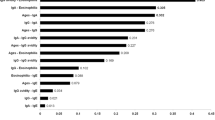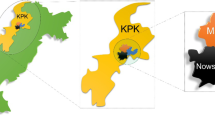Abstract
The seropositivities for infection byAscaris lumbricoides andToxocara canis were determined in children (1–15 years old) of a slum area of Caracas, Venezuela, and the levels that indicate the presence of active infection were defined. In children aged from 1 to 3 years, approximately 10% were positive for either parasite, and this figure increased to about 30% in 4- to 6-year-olds. For toxocariasis, the percentage of positivity remained at this level up to the age of 15 years. Whilst the positivity in children 10–15 years of age was comparable forAscaris andToxocara, a peak of positivity (50%) was found forAscaris at 7–9 years of age. These results indicate that for these urban slum children, infection byToxocara is essentially as common as that byAscaris and, thus, that toxocariasis represents a potential public health problem in the tropical environment that is largely overlooked.
Similar content being viewed by others
References
Bundy DAP, Medley GF (1992) Epidemiology and population dynamics of helminth infection. In: Moqbel R (ed) Allergy and immunity to helminths: common mechanisms of divergent pathway? Taylor & Francis, London, pp 17–37
Carlier Y, Yang J, Bout D, Capron A (1982) The use of an excretory-secretory antigen for an ELISA-specific serodiagnosis of visceral larva migrans. Biomed Pharmacother 36:39–42
Cypress RH, Karol MH, Zidian JL, Glickman LT, Gitlin D (1977) Larva-specific antibodies in patients with visceral larva migrans. J Infect Dis 135:633–640
De Savigny DH, Voller A, Woodruff AW (1979) Toxocariasis: serological diagnosis by enzyme immuno-assay. J Clin Pathol 32:284–288
Glickman LT, Schantz PM (1981) Epidemiology and pathogenesis of zoonotic toxocariasis. Epidemiol Rev 3:230–250
Guyatt HL, Evans D (1992) Economic considerations for helminth control. Parasitol Today 8:397–402
Herrmann N, Glickman LT, Schantz PM, Weston MG, Domanski LM (1985) Seroprevalence of zoonotic toxocariasis in the United States: 1971–1973. Am J Epidemiol 122:890–896
Jacquier P, Gottstein B, Stingelin Y, Eckert J (1991) Immunodiagnosis of toxocarosis in humans: evaluation of a new enzyme-linked immunosorbent assay kit. J Clin Microbiol 29:1831–1835
Kennedy MW, Qureshi F, Haswell-Elkins M, Elkins DB (1987) Homology and heterology between the secreted antigens of the parasitic larval stages ofAscaris lumbricoides andAscaris suum. Clin Exp Immunol 67:20–29
Lynch NR (1992) Influence of socio-economic level on helminthic infection and allergic reactivity in tropical countries. In: Moqbel R (ed) Allergy and immunity to helminths: common mechanisms or divergent pathways? Taylor & Francis, London, pp 51–62
Lynch NR, Eddy K, Hodgen AN, López RI, Turner KJ (1988a) Seroprevalence ofToxocara canis infection in tropical Venezuela. Trans R Soc Trop Med Hyg 82:275–281
Lynch NR, Wilkes LK, Hodgen AN, Turner KJ (1988b) Specificity ofToxocara ELISA in tropical populations. Parasite Immunol 10:323–337
Magnaval JF, Fabre R, Maurières P, Charlet JP, Larrard B de (1991) Application of the Western blotting procedure for the immunodiagnosis of human toxocariasis. Parasitol Res 77:697–702
Magnaval JF, Charlet JP, De Larrard B (1992) Etude double aveugle de l'efficacité du mébendazole dans les formes mineures de la toxocarose humaine. Therapie 47:145–148
Matsumura K, Endo R (1983) Seroepidemiological study on toxocaral infection in man by enzyme-linked immunosorbent assay. J Hyg 90:61–65
Nicholas WL, Stewart AC, Walker JC (1986) Toxocariasis: a serological survey of blood donors in the Australian Capital Territory together with observations on the risks of infection. Trans R Soc Trop Med Hyg 80:217–221
Ott RA, Staples M, Weekley M, Maggio ET (1985) Demonstration of both immunochemically unique and common antigenic determinants inDirofilaria immitis andToxocara canis using monclonal antibodies. Vet Immunol Immunopathol 10:147–155
Pifano F, Orihuela AR, Delgado O, Cortez R, Abdul-Hadi S, Dale M, Garmendia J (1989) La toxocariasis humana en Venezuela, especialmente en el valle de Caracas. Gac Med Caracas 96:31–42
Polderman AM, Vries H de, Van de Water TP (1980) Serological diagnosis of toxocariasis: the use of larval antigens in the ELISA. Acta Leiden 48:37–42
Soulsby EJL (1983) Toxocariasis. Br Vet J 139:471–475
Speiser F, Gottstein B (1984) A collaborative study on larval excretory/secretory antigens ofToxocara canis for the immunodiagnosis of human toxocariasis with ELISA. Acta Trop (Basel) 41:361–372
Speiser F, Weiss N (1979) Comparative evaluation of 7 helminth antigens in the enzyme-linked immunosorbent assay (ELISA). Experientia 35:1512–1513
Taylor MR, Keane CT, O'Connor P, Mulvihill E, Holland C (1988) The expanded spectrum of toxocaral disease. Lancet I:692–694
Thompson DE, Bundy DA, Cooper ES, Schantz PM (1986) Epidemiological characteristics ofToxocara canis zoonotic infection of children in a Caribbean community. Bull World Health Org 64:283–290
Van Knapen F, Van Leusden J, Polderman AM, Franchimont JH (1983) Visceral larva migrans: examination by means of enzyme-linked immunosorbent assay of human sera for antibodies to excretory-secretory antigens of the second-stage larvae ofToxocara canis. Parasitenkd 69:113–118
Welch JS, Symons MH, Dobson C (1983) Immunodiagnosis of parasitic zoonoses: purification ofToxocara canis antigens by affinity chromatography. Int J Parasitol 13:171–178
Worley G, Green JA, Frothingham TE, Sturner RA, Walls KW, Pakalnis VA, Ellis GS (1984)Toxocara canis infection: clinical and epidemiological associations with seropositivity in kindergarten children. J Infect Dis 149:591–597
Author information
Authors and Affiliations
Rights and permissions
About this article
Cite this article
Lynch, N.R., Hagel, I., Vargas, V. et al. Comparable seropositivity for ascariasis and toxocariasis in tropical slum children. Parasitol Res 79, 547–550 (1993). https://doi.org/10.1007/BF00932238
Received:
Accepted:
Issue Date:
DOI: https://doi.org/10.1007/BF00932238




